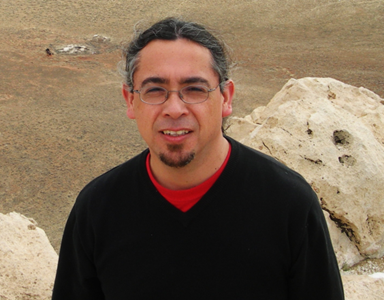
I came to the University of Nebraska-Lincoln as a graduate student in the Geography Department in August 1997. I am from Santiago, Chile, and I had experienced only three snowfalls in my whole life before my arrival in Nebraska, so the snowfall of October 25, 1997, was an extraordinary event for me. And indeed, that was a very long winter! I completed my master's degree in 2000 and went back to Chile (miraculously uncrushed) in 2001 to finish my dissertation, which I completed in 2002, with specializations in remote sensing, GIS and Human Dimensions.
In Chile I was the director of the Natural Resources Department and GIS lab chief at the National Agriculture Research Institute. I came back to Lincoln in 2004 to get married to my former UNL classmate in calculus, and started working as a scientific writer for a local GIS company. I began working for UNL in 2007 as a research specialist for the Public Policy Center specializing in human dimensions projects, and then in 2008 as a lecturer for SNR, teaching Geography of Latin America. In May 2010 I resigned from my position at the Policy Center, focusing my professional activities on lecturing, research and independent consulting work.
Research interests
My research focuses on the applications of GIS science, in particular seeking applications that will enhance users' decision-making processes and analyses. Thus, my work is inherently transdiciplinary, taking tools from different disciplines such as human dimensions, program evaluation, geocriticism, and data visualization. I actively engage with funders, stakeholders, and final users, collecting data using different methods, such as surveys, focus groups and interviews. These methods allow me to identify dominant patterns from different scientific perspectives, enriching outcome measures through geospatial, qualitative, and quantitative analysis.
Grants
Recently, online mapping has become an essential tool in the GIS and human dimensions fields. Communities use it to see how space is used and what kind of services are available. Using this platform, I am currently involved as a co-PI or PI in three research grants:
1) Evaluating web-map services for the police officers in the City of Lincoln. This is a $494,500 grant funded by the National Institute of Justice from September 2010 through September 2012. I serve as the co-PI, and Ashok Samal, Computer Science and Engineering, is the principal investigator. The three key partners on this project are the Policy Center, UNL Department of Computer Science and Engineering, and the Lincoln Police Department. We have developed a software application that is being commercialized by the Omega Group (http://www.theomegagroup.com/) to police departments across the country. The software lets police know when they're passing by the residence of a known offender, and has increased arrests. For more details about the grant, please visit http://ppc.unl.edu/project/EvaluationLocationBasedServicesPolice.
2) Building an interactive online mapping platform for historical research in Nebraska, funded by the Center for Digital Research in the Humanities. I am the principal investigator on this $13,500 grant from May 2011 through November 2012. Gene Guan is co-PI. The research consists of digitizing Nebraska historical maps from the 1900s to create a web-based interactive library of maps, photographs, and census data. Users will be able to upload photographs or documents related to a property which will be linked to the geographic location on the map.
3) Identification of “food deserts” in selected urban cities of Nebraska. I am the principal investigator on this $4,400 grant from the John C. and Nettie V. David Memorial Trust Fund. It runs from January 2012 through December 2012. The project will identify food deserts to help the community address health issues such as obesity, along with describing the demographic and socioeconomic conditions of those populations affected by the lack of accessibility to fresh food. The results will be posted on an online mapping system.
Teaching activities
I am a lecturer for SNR in the Geography and GIScience faculty area. I have taught Geography of Latin America since January 2008 as a regular lecturer, and since August 2009 as an online class. I emphasize the use of GIS and remote sensing as tools to explain environmental threats to Latin American ecosystems.
I have been involved as a guest speaker for the UNL Osher Lifelong Learning Institute program for the last two years. Most recently, I presented my research for a rural development plan in the Central Drylands of Chile. This project was a bilateral effort of the governments of Chile and Japan to improve the quality of life for poor farmers through improved technologies, better crop varieties and land use practices that will decrease soil erosion and improve soil fertility and water infiltration. My role in this project was to create GIS maps to identify alternatives to current land uses, and to encourage the active participation of farmers.
Publications and professional activities
Last year (February 2011), Kendall-Hunt Publishing Company published my book, "Geography of Latin America: A Geographic Information Systems Approach," which is available online (http://www.kendallhunt.com/store-product.aspx?id=21435).
I am an active member of the American Evaluation Association (AEA) where I contribute posts for the AEA365 blog on topics such as use of Google Refine for data analysis, PowerPoint presentations, and webinars such as Using Google Earth for Environmental Evaluation. In April 2011 I became a peer coach for those AEA members who are going to give online presentations. I am also a member of the Association of American Geographers (AAG), and the Environmental Evaluators Network, sponsored by the Environmental Protection Agency.
Other professional activities
In January 2011 I formed a consulting company called GIS and Human Dimensions, LLC, which provides consulting services to state and federal agencies.
More details at: http://snr.unl.edu/aboutus/who/people/faculty-member.asp?pid=941